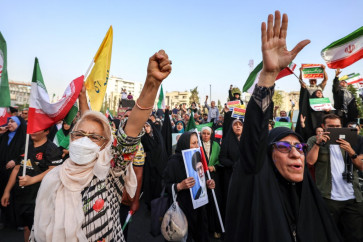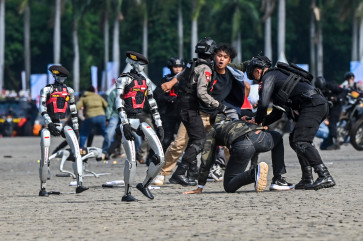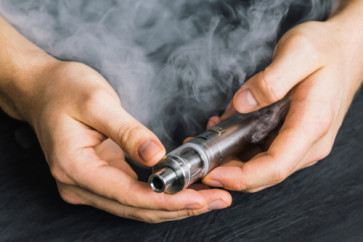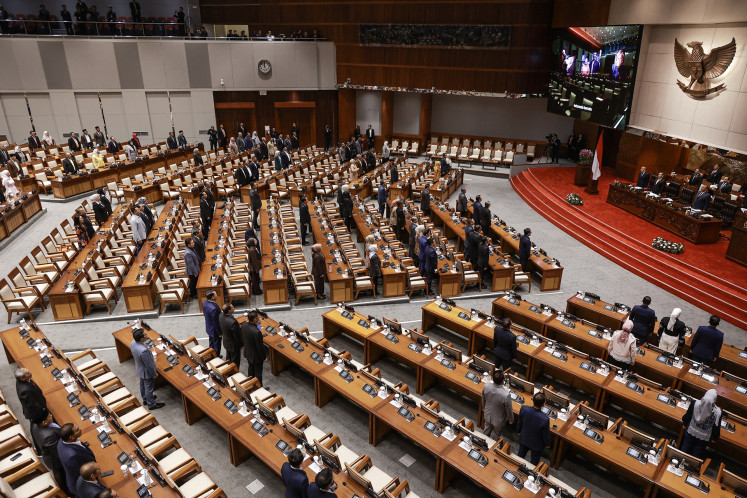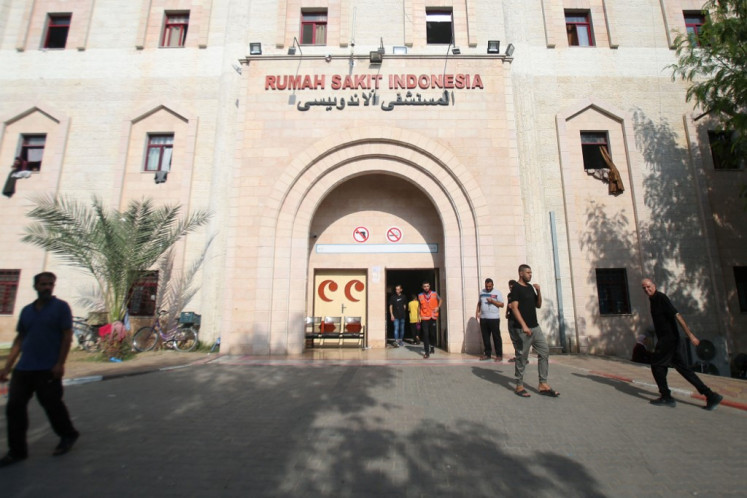Popular Reads
Top Results
Can't find what you're looking for?
View all search resultsPopular Reads
Top Results
Can't find what you're looking for?
View all search resultsAlleira: Parading Indonesia's true colors
Alleira Batik has selected the tenun woven cloth of Sulawesiâs Toraja as its design muse
Change text size
Gift Premium Articles
to Anyone
 Alleira Batik has selected the tenun woven cloth of Sulawesiâs Toraja as its design muse. (Courtesy of Alleira)" border="0" height="350" width="253">Alleira Batik has selected the tenun woven cloth of Sulawesiâs Toraja as its design muse. (Courtesy of Alleira)With flowing fabrics stippled in watercolors that glimmered like fish scales, looking âas pretty as a pictureâ is not just a clichéd idiom.
Alleira Batik has selected the tenun woven cloth of Sulawesiâs Toraja as its design muse. (Courtesy of Alleira)" border="0" height="350" width="253">Alleira Batik has selected the tenun woven cloth of Sulawesiâs Toraja as its design muse. (Courtesy of Alleira)With flowing fabrics stippled in watercolors that glimmered like fish scales, looking âas pretty as a pictureâ is not just a clichéd idiom.The evolve-or-die state of traditional Indonesian textiles created a frenzy in the local fashion industry to save batik, tenun ikat and songket from obsolescence.
Indonesian designers have plundered their imaginations to transmute what was once the attire of noblemen reserved for ceremonies and parades into mainstream prêt-à -porter casual and semi-formal get-ups.
Alleira Batik selected the tenun (woven cloth) of Toraja, an ethnic group indigenous to the highlands of South Sulawesi, as its design muse.
The heavy cloth, woven with symmetrical symbols of the regionâs traditional houses with skyward-curving roofs, buffalo horns and zig-zag representations of staircases, has been remade into garments made from silk, habutai, suede and leather in a departure from the itchy, movement-constricting textiles of old.
âEvery traditional motif in the tenun of Toraja has a story. The buffalo horn motif stems from the ideology of castes in Toraja, in that the wealthier a person is, the more buffalos he has,â explained brand ambassador, Annisa Pohan, daughter-in-law to President Susilo Bambang Yudhoyono.
Annisa modeled a form-fitting wiggle dress from the new collection, Treasures of Toraja, that further trimmed her lean frame thanks to the multi-toned paneling on the sides, which segued from dark blue and purple stamped with the buffalo-horn motif to a red batik block pattern down the middle.
The chiffon bat sleeves in muted orange flecked with light grey, despite flouting the design rule of three colors maximum, gave the dress the warm look of a glowing hearth.
 Alleiraâs brand ambassador Annisa Pohan models a form-fitting wiggle dress from the new collection, Treasures of Toraja. (Courtesy of Alleira)The clash of colors and motifs at the recent fashion show took a bold step beyond color blocking: the first outfit to debut was a red-and-brown sheath dress with a matching blazer emblazoned in white with the buffalo-horn motif.
Alleiraâs brand ambassador Annisa Pohan models a form-fitting wiggle dress from the new collection, Treasures of Toraja. (Courtesy of Alleira)The clash of colors and motifs at the recent fashion show took a bold step beyond color blocking: the first outfit to debut was a red-and-brown sheath dress with a matching blazer emblazoned in white with the buffalo-horn motif. The skirt of the dress featured layers and layers of geometric variations of the buffalo-horn pattern in four different shades of earthy brown, and yet, uncannily, would not have looked out of place at a board meeting when worn with black pumps and soft makeup.
Yet more intriguing exhibits of unabashed color blending paraded before the audience, such as a short-sleeved pistachio-green shift dress with a neck-to-bustline gold brocade framed in orange piping; then a sheath dress with three-quarter sleeves and a keyhole cutout in slimming cyan blue, with red, white and brown paneling down the middle.
However, one outfit took the art of clashing-pattern assimilation to heights unheard of: a navy long-tail shirt with dusty-orange geometric spirals and orange-and-red paneling down the middle, which was paired with a knee-length skirt in blue and red flecked with yellow geometric flok patterns.
Far from being an artless eyesore the unexpected color combinations achieved a demure, wearable look because of the air-brushing method used to apply the fabric dyes.
As in traditional batik-making, a wax-resist dyeing technique is used, meaning each dye color is applied in stages. This confers a tie-dye or dusty effect that allows warm and cold colors to transition seamlessly into one another like watercolor paints.
With tenun, on the other hand, these color segues are achieved by using different-colored threads.
âTenun is beautiful and captivating because of the variety of motifs that can be created by weaving the fabric. And itâs a shame that much of the population doesnât know about this cultural richness,â said Zakaria Hamzah, Alleira director of operations.
âIt is hoped that incorporating tenun motifs on batik will help the public become more familiar with tenun, as well as offer something new to lovers of batik.â
 Alleira Batik has selected the tenun woven cloth of Sulawesiâs Toraja as its design muse. (Courtesy of Alleira)<)
Alleira Batik has selected the tenun woven cloth of Sulawesiâs Toraja as its design muse. (Courtesy of Alleira)<)
A
span class="caption" style="width: 251px;">Alleira Batik has selected the tenun woven cloth of Sulawesi's Toraja as its design muse. (Courtesy of Alleira)With flowing fabrics stippled in watercolors that glimmered like fish scales, looking 'as pretty as a picture' is not just a clichéd idiom.
The evolve-or-die state of traditional Indonesian textiles created a frenzy in the local fashion industry to save batik, tenun ikat and songket from obsolescence.
Indonesian designers have plundered their imaginations to transmute what was once the attire of noblemen reserved for ceremonies and parades into mainstream prêt-à -porter casual and semi-formal get-ups.
Alleira Batik selected the tenun (woven cloth) of Toraja, an ethnic group indigenous to the highlands of South Sulawesi, as its design muse.
The heavy cloth, woven with symmetrical symbols of the region's traditional houses with skyward-curving roofs, buffalo horns and zig-zag representations of staircases, has been remade into garments made from silk, habutai, suede and leather in a departure from the itchy, movement-constricting textiles of old.
'Every traditional motif in the tenun of Toraja has a story. The buffalo horn motif stems from the ideology of castes in Toraja, in that the wealthier a person is, the more buffalos he has,' explained brand ambassador, Annisa Pohan, daughter-in-law to President Susilo Bambang Yudhoyono.
Annisa modeled a form-fitting wiggle dress from the new collection, Treasures of Toraja, that further trimmed her lean frame thanks to the multi-toned paneling on the sides, which segued from dark blue and purple stamped with the buffalo-horn motif to a red batik block pattern down the middle.
The chiffon bat sleeves in muted orange flecked with light grey, despite flouting the design rule of three colors maximum, gave the dress the warm look of a glowing hearth.
Alleira's brand ambassador Annisa Pohan models a form-fitting wiggle dress from the new collection, Treasures of Toraja. (Courtesy of Alleira)The clash of colors and motifs at the recent fashion show took a bold step beyond color blocking: the first outfit to debut was a red-and-brown sheath dress with a matching blazer emblazoned in white with the buffalo-horn motif.
The skirt of the dress featured layers and layers of geometric variations of the buffalo-horn pattern in four different shades of earthy brown, and yet, uncannily, would not have looked out of place at a board meeting when worn with black pumps and soft makeup.
Yet more intriguing exhibits of unabashed color blending paraded before the audience, such as a short-sleeved pistachio-green shift dress with a neck-to-bustline gold brocade framed in orange piping; then a sheath dress with three-quarter sleeves and a keyhole cutout in slimming cyan blue, with red, white and brown paneling down the middle.
However, one outfit took the art of clashing-pattern assimilation to heights unheard of: a navy long-tail shirt with dusty-orange geometric spirals and orange-and-red paneling down the middle, which was paired with a knee-length skirt in blue and red flecked with yellow geometric flok patterns.
Far from being an artless eyesore the unexpected color combinations achieved a demure, wearable look because of the air-brushing method used to apply the fabric dyes.
As in traditional batik-making, a wax-resist dyeing technique is used, meaning each dye color is applied in stages. This confers a tie-dye or dusty effect that allows warm and cold colors to transition seamlessly into one another like watercolor paints.
With tenun, on the other hand, these color segues are achieved by using different-colored threads.
'Tenun is beautiful and captivating because of the variety of motifs that can be created by weaving the fabric. And it's a shame that much of the population doesn't know about this cultural richness,' said Zakaria Hamzah, Alleira director of operations.
'It is hoped that incorporating tenun motifs on batik will help the public become more familiar with tenun, as well as offer something new to lovers of batik.'
(JP/Kindra Cooper)The more casual ensembles included a romper in royal blue, worn with an ochre-and-white short-sleeved overcoat, and a red short-sleeved tent dress with black flok detailing down the middle.
The fabric's peony motif had been deliberately faded and smudged, giving the dress an aged, rustic feel.
Combining red, yellow and orange in one outfight is conventionally a no-no, but in one sheath dress with a pleated neckline, the designers had done just that, branding the buffalo-horn motif in faded splashes about the skirt of the dress.
The menswear collection featured collared button-downs with the same degree of artistic abandon as the women's wear.
One dark-grey shirt featured a gold brocade down the middle, and was splashed with geometric patterns in orange and yellow.
Another, more conservative, shirt came in multiple shades of blood-red and scarlet fading to dusty periwinkle, with a black batik block pattern stamped down the right side, giving it an asymmetric twist.
Fifteen outfits comprised the children's collection rendered with the same flourishes of color as the men's and women's wear.
On their heads the girls wore batik fabric folded into the shape of a peony, and they wore red A-line and shift dresses in geometric spirals and the buffalo horn motif like in the women's wear collection. The color combinations ' mostly dusty reds and blues with splashes of olive green ' were decidedly more conservative, and the roomy dresses and boy's button-downs allowed for plenty of wiggle room, effectively reconciling style and comfort.
'Our goal is to adapt the traditional motifs of tenun from Toraja to an international market. In the long-term, we aim to introduce the motifs of Indonesian textiles to other countries,' said Anita Asmaya Sanin, production director at Alleira.
Indeed, tenun is not lacking in beauty, but for it to integrate into a city-slicker's wardrobe, it should be reproduced in light fabrics that allow movement and that can go from the cocktail party to the beach to the office.

